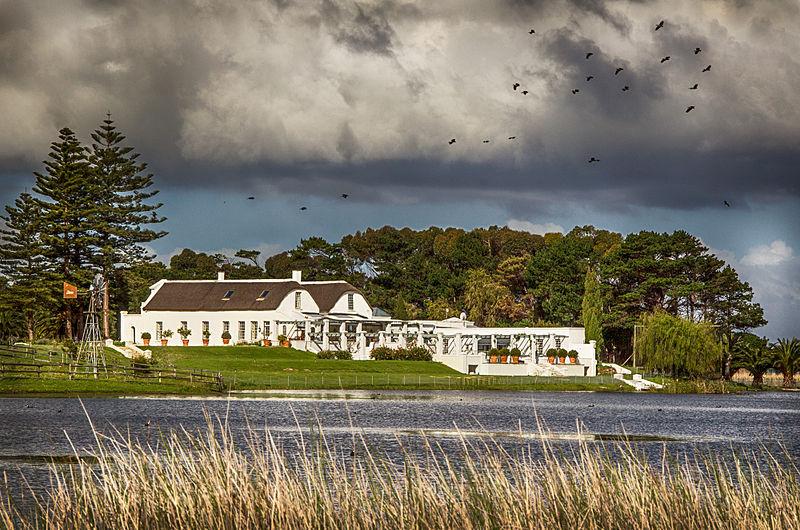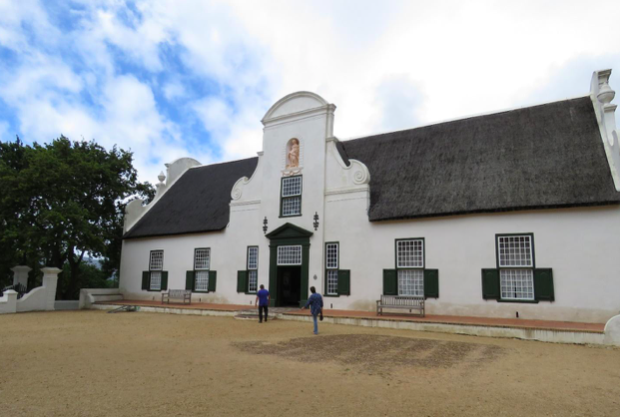
Disclaimer: Any views expressed by individuals and organisations are their own and do not in any way represent the views of The Heritage Portal. If you find any mistakes or historical inaccuracies, please contact the editor.
Ladies Mile, the road leading out of Bergvliet is well known, but the story behind the name is obscure and not to be found on the internet. It is an interesting tale which deserves to be repeated. The story is after all about the very fabric of Cape Town.
In the beginning there was the estate Groot Constantia, granted to Simon van der Stel in 1682. It was a large parcel of land, too big to be practical even in those days of slave labour. Van der Stel died in 1712, and two years later the property was sold off in three portions named Groot Constantia, Klein Constantia and Bergvliet. There were other farms in the area as well, sharing the name Constantia in one way or another.
Groot Constantia Manor House (SJ De Klerk)
Bergvliet was sold in 1776 to Hendrik Eksteen who had a son of the same name. The son inherited the farm.
Klein Constantia belonged to Lambertus Colijn who married Leonora and then died leaving Leonora a wealthy woman. Leonora presumably sold Klein Constantia at this point. She had two sons, and she set one son up in Nova Constantia to the west of Spaanschemaat Road and one in Sweet Valley to the east. In between lay Bergvliet land.
Hendrik Eksteen Jnr and Leonora Colijn were both described as strong willed and stubborn to the point of belligerence, and they were now neighbours. The scene was set for a fight.
Leonora unsurprisingly divided her time between her two sons, travelling frequently by horse or cart from one to the other, and every time she did Leonora crossed the Bergvliet farm. Eksteen objected loudly to this intrusion on his land. Leonora continued riding over it. Eksteen dug a trench across the track to physically block her.
The gloves came off. Lawyers were consulted. The case went first to the Court of the Landdrost and Heemraden which decided in Leonora’s favour. “Unacceptable!” declared Eksteen and hired Advocate Olof Martini Bergh to take the matter to the next level. At the Court of Justice it was revealed that the heart of the matter was petty in the extreme; Leonora had both 100 year-old customary rights to use the road and a right of access written into the Bergvliet Title Deed. It was a simple right of way, a servitude of long standing. Whatever, legal nuances were deployed and their Honours decided against her.
This time it was Leonora’s turn to be furious. It was time to reach for the big guns. She instructed her lawyer to go to the very top.
I have no record of when these court cases were heard, but certainly a matter that had begun under Dutch rule was concluded many years later under British rule. In British law the final arbiter of any legal matter is the House of Lords, to which Leonora, now a British subject by conquest, had access. Her appeal was lodged in London, a rare and doubtless expensive action which ended to her satisfaction. In 1827 her right of access was confirmed by the highest court possible. Hendrik Eksteen was obliged to pay all the legal costs on both sides and ended up bankrupt. The indomitable widow Leonora Colijn was able to claim victory after a fight that lasted decades.
And that’s how the road gained its name.
For the comprehensive detail I am indebted to Madeleine Barnard who wrote ‘Cape Town Stories’, published in 2007 by Struik.
Main image: Bergfliet Farmhouse via Wiki Commons (Nat Gold).
Comments will load below. If for any reason none appear click here for some troubleshooting tips. If you would like to post a comment and need instructions click here.

